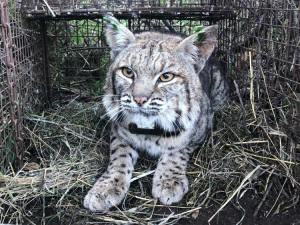Bobcat population sees resurgence but some question if hunting them
should still be allowed
 Send a link to a friend
Send a link to a friend
 [May 12, 2021]
By Zeta Cross [May 12, 2021]
By Zeta Cross
(The Center Square) – Bobcats get a bad
rap, said Jennifer Kuroda, president of the Illinois Bobcat Foundation.
Taxidermists pose them to look menacing: Teeth bared and poised to
attack. Bobcats are small creatures – the average adult weighs 19
pounds. Bobcats are very shy and extremely unlikely to attack humans,
Kuroda said.
Forty years ago, the wild bobcat population in Illinois was nearly wiped
out. To reestablish the species, the hunting and trapping of bobcats was
banned. Over many years, the Illinois bobcat population has recovered.
There are now thought to be 5,000 to 6,000 bobcats across the
state--most of them in southern Illinois, where the Shawnee National
Forest is prime habitat for the small cats.
Unfortunately for the bobcats, they are, by nature, elusive and stealthy
– making stalking them good sport for hunters. Bobcats are not hunted to
fill people's freezers with meat. Bobcats are prized for their pelts.
Stuffed bobcats are popular to display as taxidermy trophies.

In 2015, in his first week in office, former Gov. Bruce Rauner, signed
legislation making bobcat hunts in Illinois legal again for the first
time since the 1970s. As a result, beginning in 2016, the Illinois
Department Natural Resources (IDNR) began holding an annual lottery for
bobcat hunting permits. The permits are highly prized by hunters. Every
year IDNR gets 6,000 applications for the 1,000 permits that are issued
– making bobcat hunting a revenue builder for IDNR.
[to top of second column]
|

This undated photo provided by the National Park Service shows a
bobcat, dubbed B-372, who was discovered dead June 20, 2020 in
Agoura Hills. Calif.
National Park Service/Santa Monica Mountains National Recreation
Area via A

Thirty out of Illinois’ 102 counties, many of them in the Chicago area,
have opted out of the state bobcat hunt by making it illegal to hunt
bobcats within their boundaries. This past February, State Rep. Daniel
Didech, D-Buffalo Grove, whose 59th District includes several Chicago
suburbs, tried to reestablish a statewide ban on the hunting and
trapping of bobcats by sponsoring House Bill 1827, to amend the state
wildlife code. To the dismay of the Illinois Environmental Council, the
Humane Society and Kuroda, the bill was unable to gain traction.
Kuroda said she was disappointed.
“A lot of us believe that bobcat population density in Illinois is not
what it should be,” she said. “ If you are going to allow hunting, we
believe you should keep it where there is a need for it.”
Good wildlife management requires defined goals, scientific research and
transparency, Kuroda said. She and other bobcat supporters want IDNR to
hold public meetings and adhere to best practices when it comes to
managing Illinois bobcat populations.
“I’ve asked them numerous times to share their research and hold public
meetings but they are not willing to budge,” Kuroda says. |